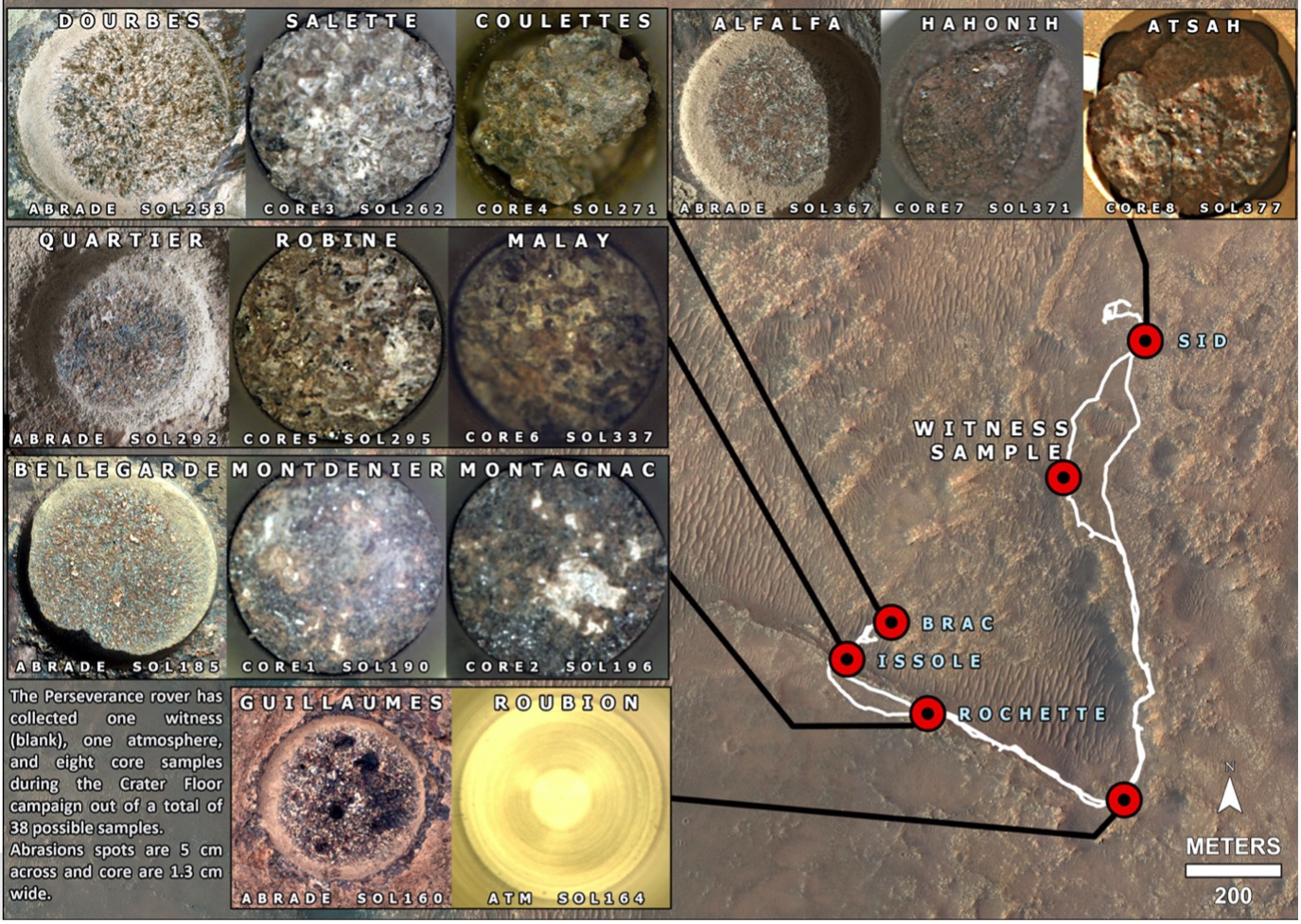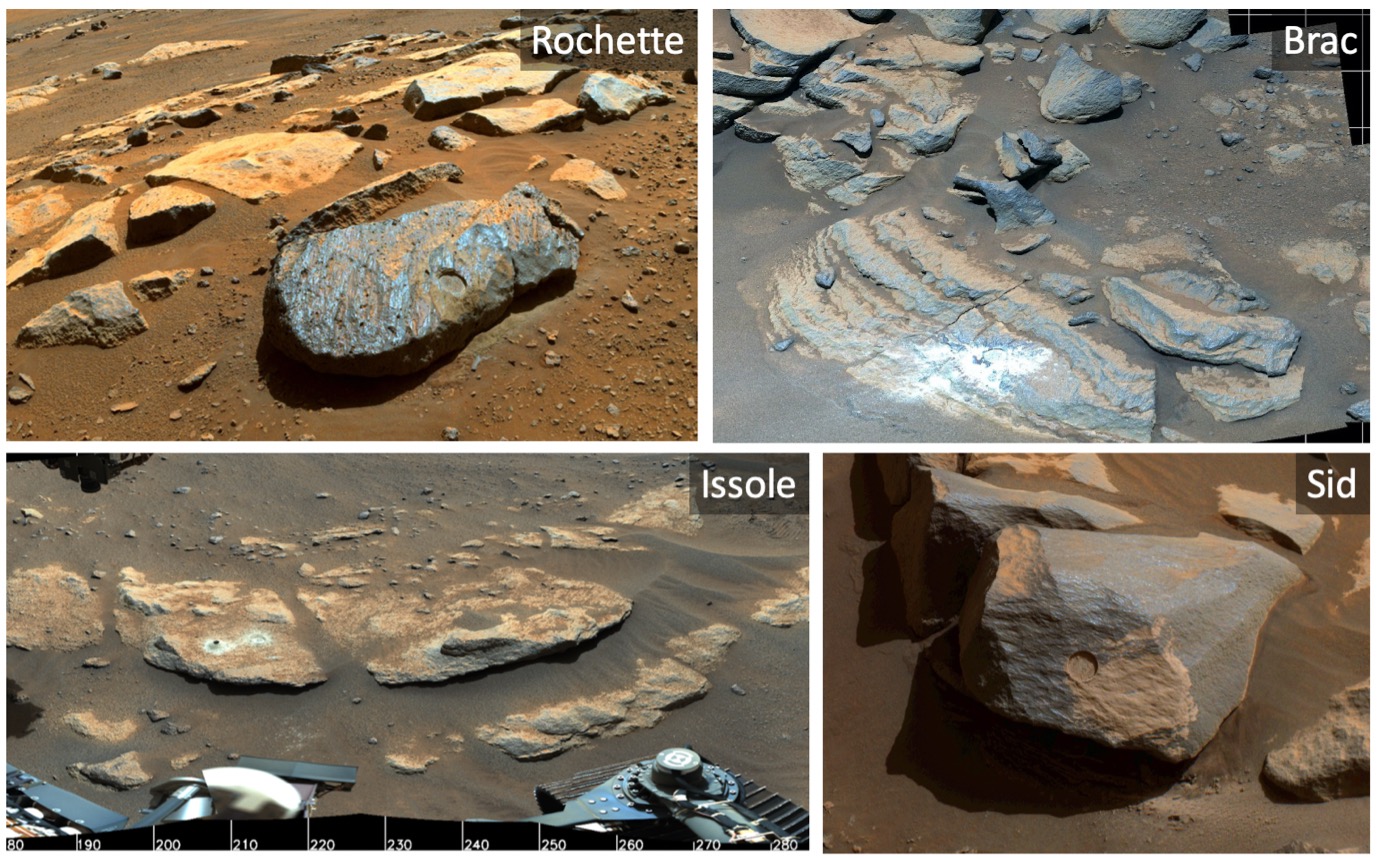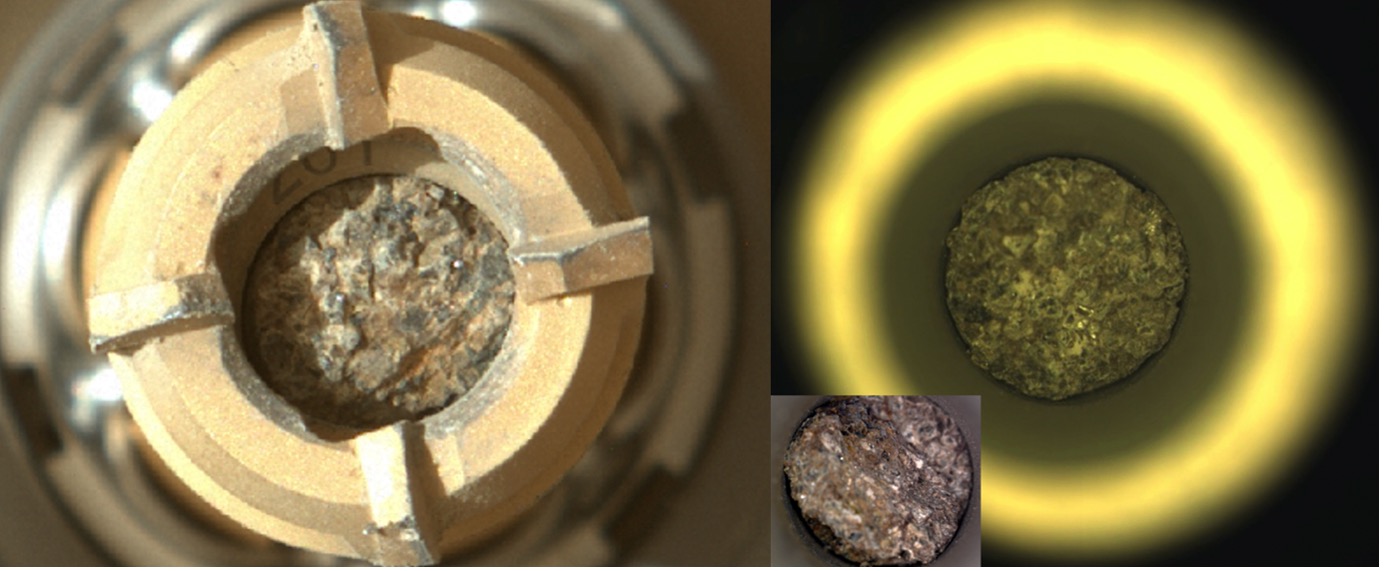Perseverance rover sampling across the Jezero crater floor: geological diversity and returned sample science potential
- 1Natural History Museum, UK; Univ. Bologna, Italy (keyron.hickman-lewis@nhm.ac.uk),
- *A full list of authors appears at the end of the abstract
The NASA Mars 2020 Perseverance rover mission aims to explore and characterise the geology and potential astrobiology of Jezero crater, which once hosted a Noachian–Hesperian delta–lake system. In addition to understanding the geological diversity of the locality, the mission will evaluate the possibility that prebiotic chemistry and/or microbial life may have occurred and become preserved in specific horizons within Jezero crater. To achieve this, the rover will collect a suite of diverse geological samples (cores of approximately 3–7 cm length) for subsequent return to Earth, whereupon these materials will be studied using high-resolution and high-sensitivity laboratory approaches. The notional suite of samples will be collected from throughout Jezero crater (the floor, delta and margin deposits), spanning numerous igneous and sedimentary lithologies in order to assure that returned sample science (RSS) objectives in geology, geochronology, geochemistry, geophysics and astrobiology will be addressed. The Perseverance rover explored the floor of Jezero crater and collected samples from two units, the Máaz formation (formerly Cf-fr, specifically the flat fractured floor) and the Séítah formation (formerly Cf-f1). Following an unsuccessful first sampling attempt at the Roubion locality of the Máaz formation, Perseverance collected its first sample pair at Rochette, and acquired a total of eight samples throughout the crater floor campaign (four in the Máaz formation and four in the Séítah formation). This presentation briefly describes observations of the samples collected across the crater floor and offers some perspectives on their utility for RSS objectives.
In the Máaz formation, sampling activities were conducted at three localities: Roubion (attempted), Rochette, and Sid. Roubion is located within a topographically low area of flat-lying, polygonally jointed outcrops; the corresponding abraded patch (Guillaumes) was noted to feature pervasive weathering and the core sample itself disaggregated during the sampling attempt. Rochette is located along Artuby ridge, a resistant geomorphological feature parallel to the contact between the Máaz and Séítah formations. Sid is an example of the rocks with massive blocky appearance that cover much of the Jezero crater floor. The Máaz formation samples are fine-to-medium grained, holocrystalline rocks dominated by pyroxene and feldspar, without the presence of olivine, and feature variable abundances of secondary minerals and salts.
For the Séítah formation, samples were collected in a region distributed irregularly across the crater floor to the southeast of the western delta (“South Séítah”). Proximity science was conducted at three outcrops: Bastide, Brac (topographically highest region of South Séítah visited by the rover) and Issole (near the contact with the Máaz formation); samples were acquired at Brac and Issole. Correlated imaging and lithochemical analyses by the rover payload instruments have identified olivine and pyroxenes with some alteration to carbonates, silica-rich phases, Mg-sulphates and perchlorates. The presence of higher concentrations of S and Cl (up to two orders of magnitude) than in any Martian meteorites is evidence of exposure of these nominally igneous rock units to brines, with indications of more than one sequence of exposure. Ongoing work on the “Quartier” abrasion aims to assess the possibility of organics.
Samples from the Máaz and Séítah formations are expected to address a number of crucial RSS themes of central significance to Mars Sample Return. Their diverse mineral assemblages will be valuable for geochemistry (e.g. magmatic history, igneous petrogenesis, melt evolution) and geochronology, both to quantify the conditions and timing of primary, high-temperature crystallisation of igneous phases and later-stage alteration events, including water–rock interactions with implications for Martian climate and habitability. Such analyses will require sub-sampling and high-precision analyses following sample return. Séítah samples will also shed light on the origin of the olivine-carbonate lithochemistrydistributed more widely across Nili Fossae and should allow better constraints to be placed on ultramafic igneous petrogenesis on the Noachian Mars. Studying the crater floor samples as a suite will facilitate a comprehensive understanding of igneous processes and subsequent alteration in Jezero crater, as well as an understanding of how the Jezero units are related in terms of the processes and chronology of the region, and indeed more widely on Mars.

Fig. 1. Crater Floor Campaign sample collection map, showing the locations of sampling for the first eight samples of the missions, together with the Roubion sampling attempt. Abrasion patches are shown alongside their corresponding core samples.

Fig. 2. Mastcam-Z images of crater floor sampling localities: Rochette and Sid (Máaz formation) and Brac and Issole (Séítah formation). Abrasion patches are 5 cm in diameter; borehole on Issole is 2.7 cm in diameter.

Fig. 3. Images of core samples during the sampling and caching process. Left image shows the Malay core sample (Issole member, Séítah formation) in the coring apparatus after sample acquisition. Right image shows a CacheCam image of the Salette sample (Bastide member, Séítah formation) within its sample tube. Inset shows the detachment of a small fragment of the Salette sample during sampling and caching.
Justin I. Simon, Barbara A. Cohen, Kathleen C. Benison, Tanja Bosak, Andrew D. Czaja, Vinciane Debaille, Elisabeth M. Hausrath, Christopher D.K. Herd, Lisa E. Mayhew, Mark A. Sephton, David L. Shuster, Sandra Siljeström, Benjamin P. Weiss, María-Paz Zorzano, Svetlana Shkolyar, James F. Bell III, Linda C. Kah, Juan Manuel Madariaga, Meenakshi Wadhwa, Andrew Steele, Adrian J. Brown, Benton C. Clark, Kevin P. Hand, Vivian Z. Sun, Kathryn M. Stack, Kenneth A. Farley
How to cite: Hickman-Lewis, K. and the Mars 2020 Science Team: Perseverance rover sampling across the Jezero crater floor: geological diversity and returned sample science potential, Europlanet Science Congress 2022, Granada, Spain, 18–23 Sep 2022, EPSC2022-762, https://doi.org/10.5194/epsc2022-762, 2022.

